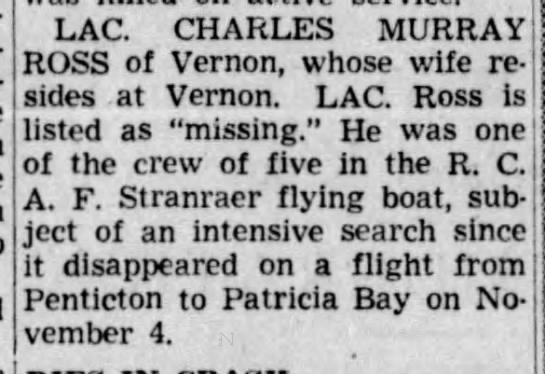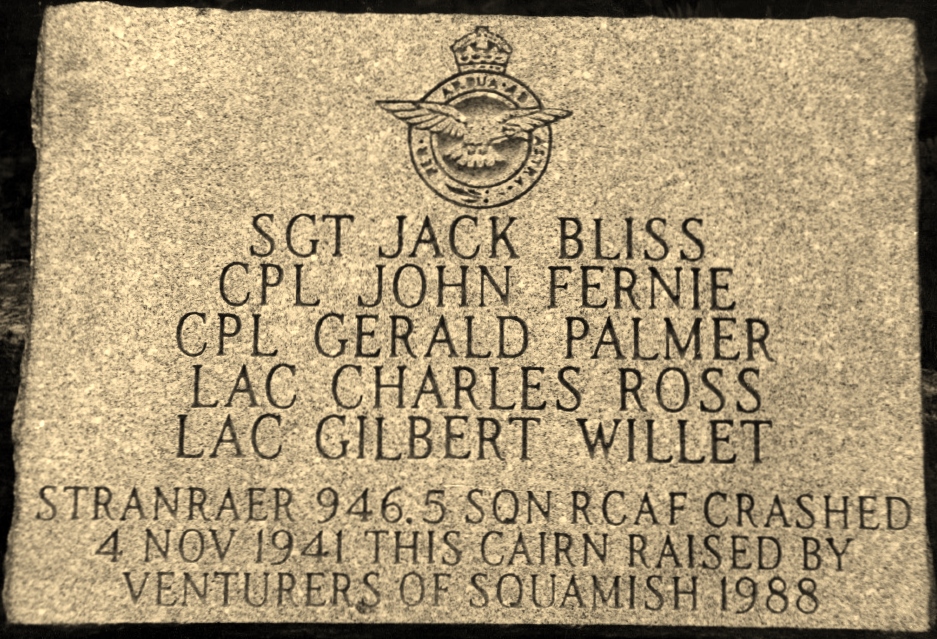





February 7, 1907 - November 4, 1941






Charles Murray Ross was the son of Joseph Edward Ross (1873-1927), tinsmith, and Eliza Corning (nee McConnell) Ross (1868-1945). His siblings were: Myrtle Jean Ashley (1895-1985), Murial Kate Seymour (1896-1964), Minnie Adeline Haberland (1987-1982), John Allister Ross, (1899-1985), Dorion Alfred Ross (1903-1939), and Evelyn Frances Cottell (1904-1978). The family was Anglican.
He married Margaret Dorothy Robinson (1904-1985) October 5, 1928, in West Vancouver. They had three children: Marion Florence (1930-1979), Richard Murray (1931-2020) and Evelyn Joan, born March 6, 1937. They resided in Vernon, BC, then moved to the Vancouver area.
In 1929, Charles attended night school where he studied sheet metal and drafting. He had been a sheet metal foreman for two years in Powell River, BC, working in sheet metal for six years before he enlisted with the RCAF. He hoped to “buy a few acres of land to live on and work at his trade when possible” after the war.
He had some military experience in 1940 with the Seaforth Highlanders in Toronto. He liked carpentry, hunting and curling. He had been sending $20 a month home to Margaret.
Charles was at No. 1 Manning Depot, Toronto, June 12, 1940, until he was sent to TTS, St. Thomas, Ontario until March 18, 1941 to train as an airframe mechanic. From February 9 to 28, 1941, he was in the hospital. He was posted to No. 5 (BR) Squadron, Dartmouth, Nova Scotia on March 19, 1941. He had two weeks leave March 3 - 17, 1941 and again July 23 to August 5, 1941.
He was an air frame mechanic (metal). He stood 5’4 ½” tall, weighed 137 pounds, had hazel eyes, brown hair, and a fair complexion. He had a 1” scar on his right knee, under side.
On November 4, 1941, Stranraer 946 was lost as the airplane and crew headed towards the BC coast from a stop at Penticton, BC hitting a snowstorm.
Crew: *Bliss, Jack Fenton, Sergeant, R58599, *Palmer, Gerald Searing, Sergeant, C4216 *Fernie, John Robert Bruce, Corporal, R50490 *Ross, Charles Murray, Leading Aircraftman, R65863 *Willett, Gilbert Fowler, Leading Aircraftman, R65048
On November 25, 1941, a letter, written by G/C F. V. Heakes for Chief of the Air Staff was sent to families of the men aboard Stranraer 946. “It is with deep regret that we have to advise you in reply to your letter of November 18, 1941, that the Stranraer aircraft in which your son…was lost while en route from Penticton BC to Patricia Bay, Vancouver Island, British Columbia is still missing…the journey on which the aircraft was lost was a very short one, particularly as the longest and most difficult part of the trip was from Ottawa had already been completed. The aircraft was in radio communication with the range to Hope British Columbia but lost communication at about that point. It was apparently later seen over Vancouver Island, only a short distance northwest of its final destination. During the time the aircraft was en route from Penticton, the weather on the coast had badly deteriorated and visibility had become very poor. For this reason, other aircraft of this type had returned to base and it would seem fairly certain that the aircraft seen was the one which is missing.
The aircraft carried fuel for a minimum range of 600 miles and for this reason search for it has proceeded a distance of several 100 miles up and down the British Columbia coast, all of the inlets and inland waterways and out to sea. Additionally, the search has covered the mainland, Vancouver Island, and the northern inland region of the United States. Not only have our own aircraft searched but the United States Air Service has have also assisted by having their aircraft cover wide areas for us. Naval vessels have also collaborated in the search. The search is still being conducted and every rumor is being followed up in the hope a successful end might be made to our efforts. The aircraft was new and in perfect condition, while the pilot was experienced on this type and had flown at operationally on the coast. Aviation has unhappily always presented those engaged in it with problems of this kind, and while every effort and precaution is exercised to ensure safety of personnel and aircraft, these efforts sometimes fail. Where they do fail, as in this case, it is natural that relatives of men missing should feel concerned as they ordinarily have little knowledge of the organization that exists to ensure safety of aircraft and to render aid when necessary. You may be reassured that no effort to discover this last aircraft has been or will be spared.”
In October 1947, the plane was located by prospector Basil Zurbriggen. [Interestingly, he had been considered missing in September 1947.]
Jerry Vernon, CAHS Vancouver Chapter President wrote on the RAF Commands Forum in 2011 indicating that a cairn was built at the site, approximately ten miles southeast of Squamish, British Columbia. The airplane flew into the hillside at the end of Indian Arm between Indian Arm and Squamish. “Any logging roads into the site were washed out long ago. The aircraft just caught the top of the ridge, otherwise they would have been over the top and looking at Howe Sound in the distance. There is a wooden cross at the crash site with the names of the crew, but vandals had partially burned it.” Details: “Reading some of the detail on 946....it had left RCAF Stn. Rockcliffe on 07 Oct 41. There was a change of pilot at Regina on 18 Oct 41, when F/O Coburn came down with acute appendicitis. Sgt. Jack Bliss took over as pilot. They landed at Brooks, Alberta, on 21 Oct 41 and bought gas from the Brooks Garage. One wingtip was damaged on the end of the CPR pier at Penticton on 23 Oct 41, and this took 12 days to repair. The aircraft departed from Okanagan Lake in poor weather on 04 Nov 41. At 1300 hrs, the aircraft reported that they were ‘SE of Vancouver in the North Sector of the Princeton Range, flying blind and descending to try and make contact with the ground.’ They were advised to remain at 11,000 ft. until they had crossed the Vancouver cone marker. At 1346, the last radio messages from the aircraft said that ‘We are lost in a dense snowstorm over land and are nearly out of fuel. No position can be decided.’ A large scale search was conducted, particularly in the Port Alberni and Mount Arrowsmith areas [Vancouver Island], as an aircraft had been heard in that vicinity. The search was discontinued on 27 Nov 41. The plane was found in heavy timber on 06 Oct 47 by an old trapper by the name of Zurbriggen. A cairn was erected, and a memorial service was held for the five lost airmen.”
Filling out the estate forms, Margaret indicated, “I do not know if Charles had any debts as he left here in February 1940 and went to Toronto with the Seaforth Highlanders and transferred to the RCAF at Toronto in June 1940 and was in the east ever since.” She never remarried.In late October 1955, families received a letter from W/C W. R. Gunn, RCAF Casualties Officer, for Chief of the Air Staff who indicated that their sons did not have a known grave and their names would appear on the Ottawa Memorial.
In the spring of 1986, the Hellcat Venture Company erected a monument to replace the deteriorated cross. Money was raised to place a memorial plaque in 1988. In 2012, a book was published to commemorate the men lost aboard Stranraer 946. See links below.
LINKS: